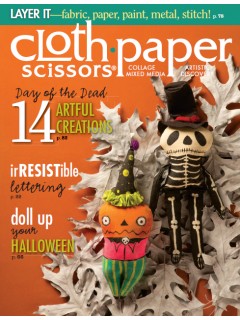After my last post, I had several (nearly ten!) emails from people who privately offered me their collective wisdom in solving my "burning issues". I'll start by telling you how I temporarily solved them, and then share all of their great ideas!
So, when I left you last, I was trying to figure out a couple of things:
a: where to get lutradur/what to use instead in my limited time frame; and
b: what to use instead of Margaret Beal's heat tool.
The unspoken issues I had were:
a: was it better to paint the substrate first and then put the fusible and then cut it out?
b: should I put the fusible on before or after I cut and paint, or can it all be done at the same time?
To begin, when I asked Jennie where she got her Lutradur, she explained that, like me (I'd been looking for it for a project for Fire a couple of months ago) she hadn't been able to find it anywhere in Canada. So when she was in the UK a couple of weeks ago, she got a bolt of it.
When she pulled it out to cut a piece off for me, I said "It looks like Pellon stabilizer!"
And SHE said - "It's made by Pellon". And I smacked myself in the head, because I have three bolts of the stuff myself, in different weights, that I bought at the Creativ Festival a couple of years ago.
At the time, I thought I was going to do a lot more thread painting (I was very taken with an exhibition of it I had seen during Quilt National in 2009) but had never really gotten 'round to it.
When I got home, I realized that none of my weights were exactly like hers, but they were probably close enough to bright, so I went for it.
The first experiment was with the heaviest of the weights I had. I cut it first, and then painted it, and THEN added the fusibile and cut it out a second time. (Which is the first pic in this post.)
Then I tried painting the stabilizer, and fusing it, then cutting it, but I couldn't see through it without a light box. I don't have one, so I used my drafting table (glass top) and a desk lamp underneath - but it's not a user-friendly option unless you have a lightbox, so I wouldn't recommend painting the stabilizer first.
And speaking of, what did I cut it with, you ask?
Well, Jennie had very generously offered to lend me her burning tool to complete the project.
However, I had done some research, and decided that its closest cousin was the Dremel Wood Burning Tool Kit (which had an attachment with a very fine point - more on that later)
I also had a very light weight Pellon, nearly translucent, that had some fusible on it already. I had been fusing that Pellon to delicate silks and lightweight chiffons to enable me to work with them more easily in other applications in the past, so thought I'd give that one a go.
I knew that the small amount of fusible on it would be useless in this particular application, so I fused the Steam-A-Seam to it, cut it to size, and then peeled off the back, using that bit of sticky-ness to adhere it to the glass.
Then I slid the whole over my image (I took the original sketch, blew it up and darkened it at a professional copy place) and commenced to cut. It worked a dream! (And my head is already filled with other applications for my Pellon and my heat tool!)
You can see that I used the tool to make more marks to "scuff it up" as you may remember the orignal rendering looked very "abused" and I wanted that look rather than the "brand spanking new" look I got with other fabrics.
Here it is all cut on on the glass - remember, it already has the fusible attached!
Now - here are the hints from all of the generous people!
No sooner did I post, than Arlee Barr wrote me and suggested that I use the Walnut Hollow "Textile Tool", and a few people wrote and suggested the Creative Versa Tool by the same company. Liniecat sent me several emails with different suggestions for both tools and sources for Lutradur, and Beth Berman sent me info on how to enlarge my image. Others wrote me and made other helpful suggestions as well, from soldering irons to wood burning tools, a couple of you also suggested the Dremel Wood Burning kit I had already found.
Ladies - all of you - I'm truly touched by your generosity of spirit and helpfulness! Apparently, there's nothing we can't solve together. :)
As for me, after I cut my fused Pellon, I painted it - right on the glass!
To find out whether it worked, check back in on Friday. Till then...














This is a great collaboration, Kit. I'll be back to see on Friday. It is gonna be great!
ReplyDeleteAs I've been away and came into the middle of this story, I'm looking forward to 'finis'! I use a wood-burning tool that I got in a hardware store years ago, with several tips...and I thought you could still get Lutradur here -- got mine at Stitches (Salt Spring Island) at Quilt Canada 2010 in Calgary...but perhaps not (can't find it on their website now)...
ReplyDeleteyou see........the combined knowledge of wise women!
ReplyDeleteKit - waiting with baited breath for the finish! I love the fact that something as 'soft and fluffy' as quilting can be political. We had a great exhibition here a couple of years ago at the Victoria and Albert Museum London, and that made it very clear that radical women have been stitching subtle political messages for years. You are keeping the flag flying! H xx
ReplyDeleteGlad to see its working out - can't wait to see it finished !!
ReplyDelete